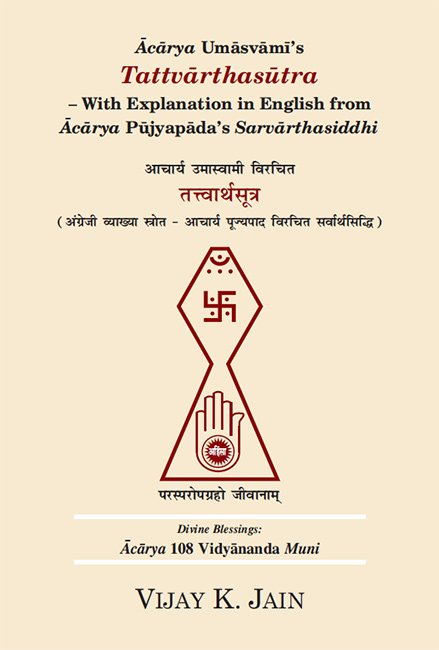Tattvartha Sutra (with commentary)
by Vijay K. Jain | 2018 | 130,587 words | ISBN-10: 8193272625 | ISBN-13: 9788193272626
This page describes occupation of the forms of matter (pudgala) which is verse 5.14 of the English translation of the Tattvartha Sutra which represents the essentials of Jainism and Jain dharma and deals with the basics on Karma, Cosmology, Ethics, Celestial beings and Liberation. The Tattvarthasutra is authorative among both Digambara and Shvetambara. This is verse 14 of the chapter The Non-living Substances and includes an extensive commentary.
Verse 5.14 - Occupation of the forms of matter (pudgala)
Sanskrit text, Unicode transliteration and English translation of Tattvartha sūtra 5.14:
एकप्रदेशादिषु भाज्यः पुद्गलानाम् ॥ ५.१४ ॥
ekapradeśādiṣu bhājyaḥ pudgalānām || 5.14 ||
The forms of matter (pudgala) occupy (inhabit) from one space-point (pradeśa) onwards. (14)
Hindi Anvayarth:
अन्वयार्थ: [पुद्गलानाम्] पुद्गल द्रव्य का अवगाह [एक प्रदेशादिषु] लोकाकाश के एक प्रदेश से लेकर संख्यात और असंख्यात प्रदेश पर्यन्त [भाज्यः] विभाग करने योग्य है-जानने योग्य
Anvayartha: [pudgalanam] pudgala dravya ka avagaha [eka pradeshadishu] lokakasha ke eka pradesha se lekara samkhyata aura asamkhyata pradesha paryanta [bhajyah] vibhaga karane yogya hai-janane yogya
Explanation in English from Ācārya Pūjyapāda’s Sarvārthasiddhi:
The material objects having form are different from the non-material substances like the medium of motion. These extend from one unit of space to numerable, innumerable and infinite units of space. What is the nature of their accommodation?
One elementary particle (paramāṇu) occupies one space-point (pradeśa). Two elementary particles, either combined or separate, occupy either one or two space-points (pradeśa). Three elementary particles, either combined or separate, occupy one, two or three space-points (pradeśa). In the same way, molecules of numerable (saṃkhyāta), innumerable (asaṃkhyāta) and infinite (ananta) atoms occupy one, numerable (saṃkhyāta) or innumerable (asaṃkhyāta) space-points (pradeśa) of the universe-space (lokākāśa). Now, it stands to reason that the non-material (amūrta) substances such as the media of motion and of rest can be accommodated in the same place at the same time without obstruction. But how can it be possible in case of material (mūrta) objects? It is possible even in case of material (mūrta) objects too as these have the nature of getting accommodated and of getting transformed into subtle forms. As the lights from many lamps in a room intermingle without causing obstruction to each other, in the same manner, the material (mūrta) objects can get accommodated in the same space at the same time. It should be understood in this manner from the authority of the Scripture also: “The universe is densely (without inter-space) filled with variety of infinite-times-infinite forms of matter (pudgala) of subtle (sūkṣma) and gross (sthūla) nature in all directions.”
